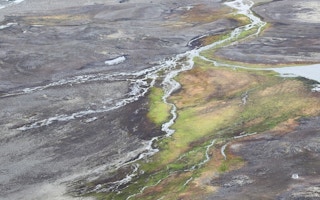Green may not automatically mean innocent or planet-friendly after all. Korean and German scientists have identified a mechanism that could encourage plants to take up more carbon dioxide – and at the same time amplify Arctic warming by 20 per cent. This counter-intuitive finding is published in the Proceedings of the National Academy of Sciences.
Jong-Yeon Park of the Max Planck Institute for Meteorology and colleagues have been looking at the role of phytoplankton, those tiny marine plants that flourish around land masses, exploit the nutrients that flow from rivers and turn the blue ocean sea-green. Like any grass or shrub or tree, they exploit sunlight and employ photosynthesis to soak up atmospheric carbon dioxide.
So as the Arctic Ocean warms, because of increasing emissions of carbon dioxide from the burning of fossil fuels, the ice melts, the blue sea water absorbs more sunlight, and the green things get a chance to grow and soak up some of that greenhouse gas as organic carbon in plant tissues. This is what engineers call negative feedback.
But it may not work like that. The scientists matched up a model of the climate system with a model of the ecosystem and did all the sums again. And they found that instead of reducing warming, an explosion of phytoplankton growth could actually amplify it.
More warming
If the seas warmed and the ice melted, then the overall albedo – the reflectivity of the Arctic – would be changed. More high energy solar radiation would get into the sea, and the phytoplankton harvest would be greater and go on for longer.
But more phytoplankton would mean more biological activity, which would directly warm the surface layer of the ocean, “triggering additional positive feedbacks in the Arctic, and consequently warming the Arctic further,” the authors warn.
“We believe that, given the inseparable connection of the Arctic and global climate, the positive feedback in Arctic warming triggered by phytoplankton and their biological heating is a crucial factor that must be taken into consideration when projecting future climate changes,” said Jong-Seong Kug, a professor at Pohang University of Science and Technology in Korea.
Science like this is a reminder that the climate system is a subtle and complex machine driven by sunlight, atmosphere, water – and carbon. A British team has warned that rainforests could in fact be emitting much more carbon than climate modellers have accounted for. That’s because they haven’t allowed for all of the dead wood.
“
We believe that, given the inseparable connection of the Arctic and global climate, the positive feedback in Arctic warming triggered by phytoplankton and their biological heating is a crucial factor that must be taken into consideration when projecting future climate changes.
Jong-Seong Kug, a professor at Pohang University of Science and Technology in Korea
Marion Pfeifer of Imperial College and colleagues report in Environmental Research Letters that they surveyed a large area of forest in Malaysian Borneo to make their calculations.
Pristine, untouched forest is rare. Most forests provide an income for someone, and increasingly parts of the great forests are exploited by loggers and planters. In untouched forests, dead wood makes up less than 20 per cent of the biomass. Dr Pfeifer and her colleagues found that in partially-logged forests, the dead wood could account for 64 per cent of the biomass.
Details such as this could send climate modellers back to the drawing board. That is because the great riddle of climate science is: where does all the carbon go? The assumption has been that forests are “sinks” that collect atmospheric carbon. But that depends on the forest.
“I was surprised by how much of the biomass dead wood accounted for in badly-logged forests. That such logged forests are not properly accounted for in carbon calculations is a significant factor. It means that a large proportion of forests worldwide are less of a sink and more of a source, especially immediately following logging, as carbon dioxide is released from dead wood during decomposition,” Dr Pfeifer said.
“Selectively-logged tropical forests now make up about 30 per cent of rainforests worldwide. That means such global calculations are wrong at least 30 per cent of the time.”










